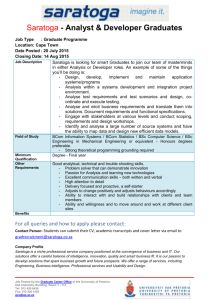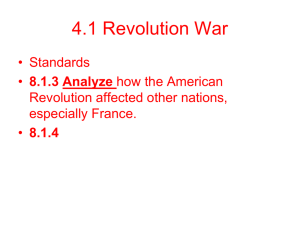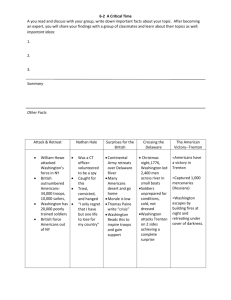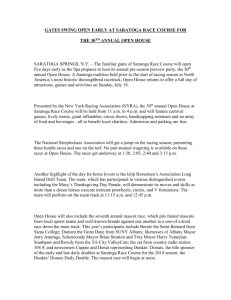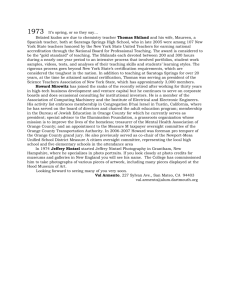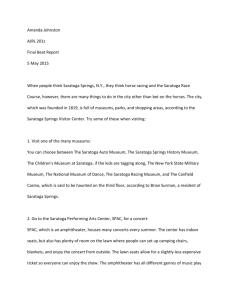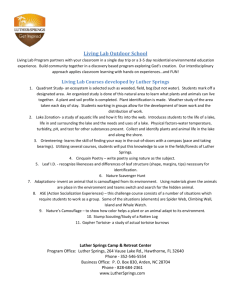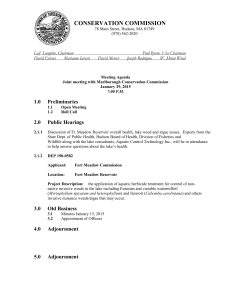recreation, economic status, and proximity to saratoga lake
advertisement
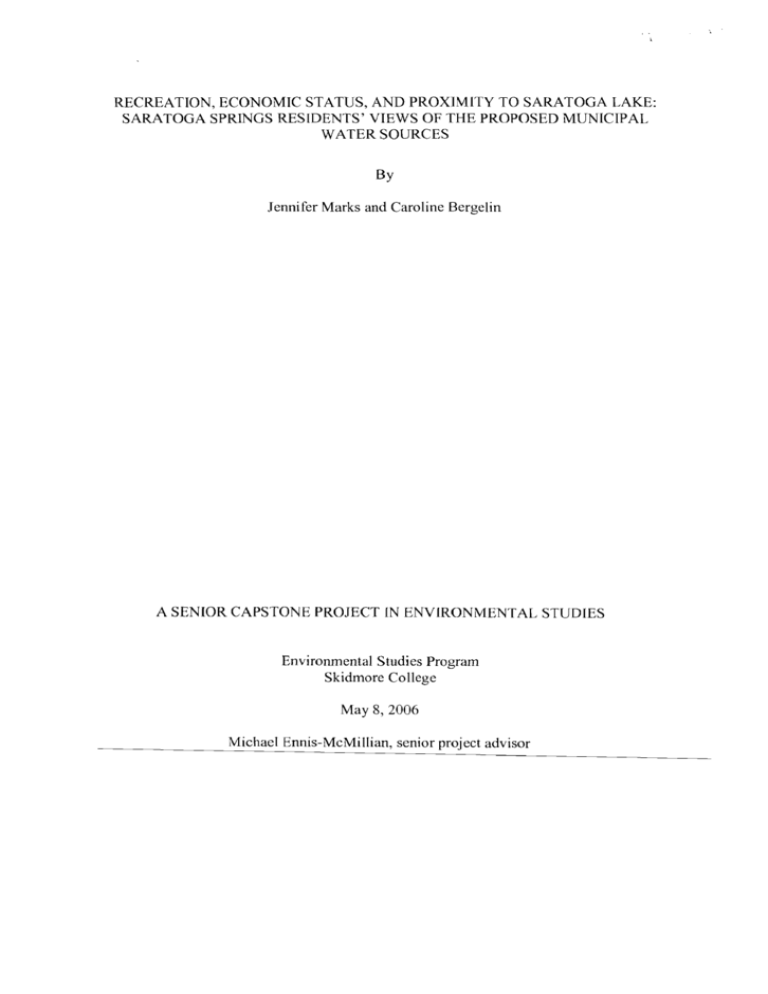
RECREATION, ECONOMIC STATUS, AND PROXIMITY TO SARATOGA LAKE:
SARATOGA SPRINGS RESIDENTS' VIEWS OF THE PROPOSED MUNICIPAL
WATER SOURCES
By
Jennifer Marks and Caroline Bergelin
A SENIOR CAPSTONE PROJECT IN ENVIRONMENTAL STUDIES
Environmental Studies Program
Skidmore College
May 8,2006
Michael Ennis-McMillian, senior project advisor
RECREAnON, ECONOMIC STATUS, AND PROXIMITY TO SARATOGA LAKE:
SARATOGA SPRINGS RESIDENTS' VIEWS OF THE PROPOSED MUNICIPAL
WATER SOURCES
By
Jennifer Marks and Caroline Bergelin
ABSTRACT
As Saratoga Springs attempts to accommodate a population increase, new water
resources are needed and an assessment of how this may affect the residents of Saratoga
Springs is necessary in order to understand the impacts on the community. A quantitative
and qualitative survey was conducted which provides insight into how Saratoga Springs
residents respond to the proposed new water source of Saratoga Lake or the upper
Hudson River. The survey illuminates how recreational activities, household economic
levels, and varying distances from Saratoga Lake influence how the community values
Saratoga Lake as a resource. This is important an aspect for maintaining the social and
environmental sustainability of the resource and the community.
2
RECREAnON, ECONOMIC STATUS, AND PROXIMITY TO SARATOGA LAKE:
SARATOGA SPRINGS RESIDENTS' VIEWS OF THE PROPOSED MUNICIPAL
WATER SOURCES
By
Jennifer Marks and Caroline Bergelin
Introduction
Currently, Saratoga County and the City of Saratoga Springs are involved in a debate
regarding the development of a new municipal water source for the City of Saratoga
Springs. The need for a new drinking water source has been driven primarily by the
implications of population growth within Saratoga Springs on the long-term sustainability
of the City's current water sources, Loughberry Lake, Bog Meadow Brook and the
Geyser Crest Well Field (The City of Saratoga Springs Water Development Project
2006). According to Census data, the population of Saratoga County grew from 200,635
in 2000 to 212,706 in 2004, indicating a growth rate of 6% (CDRPC 2006). Within
Saratoga Springs specifically, the population was 26,186 in 2000, increasing to 27,332 in
2003, indicating a comparable growth rate of 4.7% (CDRPC 2006). Over the next ten
years, the growth rate within Saratoga Springs will increase significantly by 11.9%
(CDRPC 2006). The projected population increase is likely to put pressure on the current
water sources, which have been called "finite, fragile, and unable to support the long
term" (Benton 2002).
Accommodating population growth requires the City of Saratoga Springs to
explore the most sustainable water resource for the long-term. Currently, the two options
up for debate are the use of Saratoga Lake and the upper Hudson River as alternative
water sources. The City has proposed the use of Saratoga Lake as a municipal water
3
source (Benton 2002). This proposal received negative feedback from Saratoga County
and residents from other neighboring municipalities that share the lake with the City of
Saratoga Springs (The Saratogian February 16, 2006). Saratoga County's proposal of the
upper Hudson River was drafted in response to residential concerns regarding restrictions
placed on recreation if Saratoga Lake becomes a municipal water source (SLA 2006; The
Saratogian September 10,2006). The type of recreational activities practiced on Saratoga
Lake varies drastically by season; however, the activity itself remains fairly constant
throughout the year. In the summer months, the lake is an active resource, providing
residential boat access, fishing, crew training, and sailing to those living both on and off
the lake. Winter on the lake offers different recreational opportunities, where one can
observe ice fishing huts, ice skating, and even the occasional all-terrain vehicle.
Throughout the seasons, Saratoga Lake provides residents with a social resource and a
sense of community. For this reason, recreation has become an element deeply integrated
within discourse regarding the use of Saratoga Lake as a municipal water source.
There is an assumption that those residing closer to Saratoga Lake are more
concerned about recreation, particularly because the most active individuals are lake­
front residents (The Saratogian February 16, 2006). In the Town of Saratoga, 35 to 40
residents wrote the Town Supervisor Robert Hall in an effort to stop the City of Saratoga
Springs from using Saratoga Lake as a municipal water source (The Saratogian February
16, 2006). Hall, also a lake-front resident, stated that he is opposed to the City's proposal
because if the lake becomes a reservoir, recreation will be limited due to water quality
concerns (The Saratogian February 16, 2006). In addition, the Saratoga Lake Association
(SLA), a homeowner organization advocating the health of the lake, has voiced concerns
4
about limitations on recreation that could arise if Saratoga Lake becomes the new
municipal water source. In a letter aimed to increase public awareness and gather
community support, the SLA states that it "is very concerned that the proposed water
withdrawal will affect the health, safety and recreational use of Saratoga Lake" (SLA
2006). Clearly, opposition for the use of Saratoga Lake has mobilized over recreational
concerns.
Moreover, opposition from environmental organizations near Saratoga Lake has
contributed to the perceived notion that those near the lake are more opposed to its use as
a municipal water source. The Saratoga Lake Protection and Improvement District
(SLPID) are defined as "a governmental organization responsible for the maintenance of
Saratoga Lake's water quality" (SLA 2006). Prior to the water resource debate, SLPID's
primary role was to collect taxes from lake-front residents to facilitate weed control on
Saratoga Lake. However, their concerns have evolved in the face of the water resource
debate to include the preservation of recreation on the lake. Ed Dweck, the chairman of
SLPID, publicly stated in 2005 that he is "concerned about recreation" despite what the
Draft Environmental Impact Statement (DEIS) says (The Saratogian October 21, 2005).
Clearly, Ed Dweck and other members are skeptical of the DEIS and have new concerns
that focus on safeguarding their recreational abilities on Saratoga Lake.
According to the City's DEIS, "the Saratoga Lake alternative meets the City's
long-term and emergency back-up needs, is the most affordable option for the public, and
would have minimal impacts on the environment" (Barton & Longuidice, P.C. 2001). In
the Scoping Responsiveness Document (the precursor to the DEIS) prepared by the City
of Saratoga Springs in 200 I, acknow ledged "that the lake is used for a wide range of
5
recreational activities" (Barton & Longuidice, P.c. 2001). Furthermore, the document
states that "there would be no need to significantly restrict current recreational uses of
Saratoga Lake ifit were to be used as a public water supply" (Barton & Longuidice, P.C.
200 I). This was confirmed with the DEIS from 2003, as the potential environmental
impacts and mitigation measures indicate that it would not be necessary to restrict
recreational uses of Saratoga Lake. However, a Draft Study for SLPID conducted in
2001 and cited in the DEIS, "suggests that it may be appropriate to limit boat traffic on
Saratoga Lake for purposes of boating safety and recreational enjoyment." Therefore, the
City of Saratoga Springs holds that if future restrictions are to be made, they would likely
be to "protect the boating public rather than to protect water quality" (DElS 2003).
Evidently, the City 0 f Saratoga Springs sees the importance of protecting the recreating
public and claims that restrictions imposed on the Lake would be to ensure their safety
while visiting the Lake.
The City of Saratoga Springs and its residents as well as neighboring
municipalities share concerns over the preservation of Saratoga Lake as a recreational
resource. Residents believe that preserving Saratoga Lake ensures the sustainability of a
deeply embedded recreational culture that they have come to value. The purpose of this
study is to evaluate the publics' inherent value of Saratoga Lake and the recreational
culture that has been created. Specifically, Saratoga Springs inner and outer district
residents are examined regarding how recreation, economic status, and proximity to
Saratoga Lake influences their value of Saratoga Lake, as well as how all three inform
public opinion on the use of Saratoga Lake or the upper Hudson River as municipal water
sources. This study uses residential surveys that measure residents' attitudes and
6
opinions of the water resource debate to inform stakeholders in the municipal water
source debate. Guy and Rogers (1999) found that organizing survey efforts around a
community's environmental, economic, and social needs helped elected officials identify
the interdependence in all three areas. Relying on this approach, this study provides
socio-economic data that shows how Saratoga Lake has come to be valued as a
recreational resource. Finally, in order to situate the socio-economic data within a
broader geographic context, this study provides stakeholders with a visual representation
of the distribution of recreation participation through Geographic Information Systems
(GIS). Aspinall and Pearson (2000) found GIS to be useful by situating site-specific
indicators within a broader geographic context. Access to the Saratoga County Office of
Real Property Service residential parcel information combined with the GIS program
situated Saratogians' specific recreation activities within varying geographic proximities
to Saratoga Lake.
Previous research has indicated that recreation is an integral part of maintaining
social sustainability within a community (Guy and Rogers 1999). Social sustainability
involves issues that affect residents' quality of life (Guy and Rogers 1999). It includes
population density, adequate housing, education, recreation, culture, welfare, and a
myriad of other social conditions (Luther 1997). Given the projected population increase
within the City of Saratoga Springs and Saratoga County, several of these conditions are
areas of concern because economic development cannot be sustained when a
community's social environment fails to meet quality of life expectations (Bonnett 1993).
Another facet of a community's culture that affects social sustainability is residents'
feelings about their community (Eliason, Rogers, and Geertsen 1992). Information about
7
residents' opinions, behaviors, and attitudes can provide the human and social perspective
that helps identify activities and practices important in sustaining communities (Guy and
Rogers 1999). Inevitably the use of Saratoga Lake or the upper Hudson River will affect
the character and Saratoga Springs' sense of community.
Quantitative and Qualitative Methods
In order to gain a quantitative understanding about whether or not recreation, economic
status, and proximity to Saratoga Lake influence public opinion about the proposed water
resources, we use primarily quantitative data with some supplemental qualitative data.
The combination of quantitative and qualitative data is a process known by social
scientists as triangulation (Todd 1979). Triangulation involves the use of multiple
methods to research the same phenomenon. The idea is for the weaknesses in anyone
method to be compensated for by the strengths of another (Todd 1979). We conduct a
full-scale quantitative survey study, which is then informed by an open-ended qualitative
question included at the end of the survey. This question is placed at the end of the
phone interview in order to offer the participant a moment to speak openly about the
water resource issue.
Preliminary Qualitative Component
In the first stage of the research, we conduct a series of informal semi-structured
qualitative interviews to gain a general understanding of the issues that effect Saratoga
Springs residents. These interviews range from 8 to 10 residents who reside within the
City of Saratoga Springs (see Figure I in Appendix A for reference to city locale). We
8
select interviewees through the use of convenience sampling, a method that focuses on
any individual willing to converse about the subject (Yu and Cooper 1983). We then
conduct the informal qualitative interviews in public domains in the commercial district
of the city of Saratoga Springs. These preliminary surveys help design a survey that
addresses the relevant issues effecting Saratoga Springs residents. We then create a
quantitative survey that includes questions on consistent themes and issues that appear
during the initial qualitative interviews.
Quantitative Survey with a Qualitative Component
After addressing the public issues, we conduct telephone surveys. We organized
the survey into three respective parts (see Figure 2 in Appendix A for survey questions).
. The first part of the survey includes questions regarding specific recreational activities
performed by Saratoga Spring's residents on the Lake. These questions took into account
the seasonality of recreation and include questions about each season. The second part
includes demographic questions. Finally, as a way to create a study based on
triangulation, an open-ended question supplements the quantitative information with
additional qualitative information. The structure of this question varies based on the
participants' responses during the survey. After conducting all the surveys, we review
the responses to the qualitative question and create a typology that represents consistent
themes that would supplement and inform the quantitative data.
9
Survey Coding System
We construct an incremental survey with a coding system that is assigned to each
question. For example, 10 I, "Do you use Saratoga Lake for recreation?" is assigned two
numerical values, a value of 1 (one) assigned to "yes" and a value of 2 (two) for "no"
(See Figure 2 in Appendix A for specifics). For more complex issues such as annual
income, we break the coding system into six numerical increments. Each question's
coding system accounts for all possible responses. Regardless of the complexity of the
issue, each question included a coded response for non-applicable responses, confused
responses, and refusals. 103, a question about the gender of the participant, has an
alternate coding system which does not fit general coding system. For 103, we assume
the gender and record this so as not to offend the participant (Interview with Bill Fox,
conducted 23 February 2006).
This coding system facilitates the quantitative analysis and organizes the data for
entry into SPSS (Statistical Package for the Social Sciences); a software system used by
social scientists for data management and analysis. SPSS performs multivariable
statistical analyses and sorts and merges files for data manipulation (SPSS 2006). The
time constraints of this project demands fast processing; SPSS dealt automatically with
the complex data sets created during the analysis process (SPSS 2006). We used SPSS to
run cross tabulations to assess correlations between the variables ofrecreation
participation, economic status, Saratoga Springs resident opinion of the proposed
municipal water sources and proximity to Saratoga Lake. In addition, we used SPSS to
conduct frequency tests and to compute means, standard deviations, and p-values for data
sets.
10
Determining Proximity to Saratoga Lake
The survey evaluates a stratified random sample of residential households in
Saratoga Springs. We use Geographic Information System (GIS) to create five, one and a
quarter mile geographic buffer zones that measure and map differing proximities from
Saratoga Lake. A buffer zone is a key aspect of a stratified random sample as it allows
researchers to organize the total sample population into smaller geographical zones
(Babbie 1992: 215). Earl Babbie (1992) holds that stratification by geographical location
increases representation in various groups such as social, ethnic, or recreational groups.
The use of buffer zones provides a more representative sample in terms of socio­
economic status and public opinion.
We restrict the buffer zones established for this study to Saratoga Springs' inner
district and outer district (see Figure 1 in Appendix A). The study focuses solely on
Saratoga Springs as a way to assess citizens' opinions regarding the proposed municipal
water sources. Saratogians' opinions are more relevant within the context of Saratoga
Springs since the issue originated in and continues to be subject of discussion within the
City of Saratoga Springs. Fundamentally, Saratogians' are the most affected by the
proposed municipal water resources due to tax increases, property value declines, and
potential restrictions on recreation (The Saratogian February 16, 2001)
The Saratoga County of Real Property Service provided land parcel data from
2005 for Saratoga's inner and outer districts in the form of shapefiles. These are visual
representations of demographic data that are uploaded into GIS to generate a visual
reference for parcel information. The attribute table associated with the parcel
information provides further demographic information, specifically the location and
11
zoning classification of each residential parcel within Saratoga Springs. The Office of
Real Property Service of Saratoga County provides a zoning classification for each
parcel, categorized generally as residential, commercial, agricultural, or industrial. We
consider only residential land parcels as potential survey participants and make no
distinctions between renters or homeowners; both are considered.
Stratified Random Sampling
We generate a sampling frame 01'30 residential parcels for each of the five buffer
zones, resulting in a total sample size of 150. To begin the stratified random sampling,
we assign numbers to each parcel within the sampling frame of the five individual buffer
zones. We use a random number generator to select a total 01'30 random numbers which
are assigned to residential parcels within each buffer zone (True Random Number
Service 2006). GIS generates a spreadsheet consisting of the total number of residential
parcels within each buffer zone and a corresponding numerical value for each parcel in
ascending order. The values begin with zero and continue through the full list of
residential parcels within the buffer. Then, we enter the addresses of each residential
parcel into an electronic telephone directory to generate phone numbers. Addresses were
entered into an online phone directory immediately after generating the random numbers
(Whitepages.com 2006). For addresses that came up as unlisted, we generate another
random number to account for the unlisted number. This process continues until we
arrive at a sampling frame of 30 residential parcels. In their 2005 study conducted under
the same time constraints, DiSciacca and Reiss found that the same online phone
directory was a successful means of generating phone number (DiSciacca and Reiss
12
2005: 6). In addition, Yu and Cooper (1983) found that telephone surveys and personal
interviews are the most effective means in generating responses when compared with that
of postal mail surveys. Our study attempts to replicate the successes of both research
teams.
Once the sampling frame is complete for each of the five buffer zones, both
researchers conduct the telephone surveys independently from one another. The
telephone surveys are conducted randomly within a three and a half week period (March
2,2006 to March 27,2006) between the hours of 12pm and 7pm on various days of the
week. This accounts for individuals with different schedules (DiSciacca and Reiss 2005:
6). Each telephone number is called a total of four times in order to increase the response
rate. If there is no answer after the fourth phone call, the residential parcel is excluded
from the data analysis process.
Quantitative Survey Results
The results of the survey and the qualitative interviews seek to determine how Saratoga
Springs residents' opinion is formed on the use of Saratoga Lake or the upper Hudson
River as municipal water sources. In order to test the statistical significance of our study,
we performed Chi-square and asymptotic significance tests for each cross-tabulation. We
defined statistical significance as p<.05 (Babbie 1992). Table 1, found below, provides
the p-values for each cross-tabulation between the control and outcome variables.
13
Table 1:
Statistical Significance of Crosstabluations
Control
Variables
Outcome Variables
In the Summer Months
Recreation
Participation
p<O.001 - Significant
In the Winter Months
p<O.031 - Significant
Indicator of Public Opinion
on the Use of Saratoga lake
p<O.044 - Significant
p<O.920 - Not
Sign.
p<0.437 - Not
Sign.
Indicator of Public Opinion
on the Use of upper Hudson
River
p<O.069 - Not Sign.
p<O.969 - Not
Sign.
p<0.451 - Not
Sign.
Proximity
Income Status
p<0.442 - Not
Sign.
Indicator of Recreation
During the data collection process, 150 residential households we called out of the
total 8,687 residential households in Saratoga Springs. We surveyed 65 residential
households, resulting in a total response rate of 43.3 percent. The response rates for each
buffer vary respectively with a mean response rate of 41.65 percent (See Table 2 in
Appendix). Of those who were surveyed 49.2 percent were male and 50.8 percent were
female. A typical respondent held an undergraduate degree, was between the ages of 46
and 64, and declared an annual income of above $81,000.
14
Figure 3:
Saratoga Springs Residents Opinion:
The Use of Saratoga lake and the upper Hudson River
60%
50%
41.5%
Ul
"C
:g
40%
Q)
Ul
:J
~-I
33.8%
o
J:
"C
Q)
~ 30%
e
­
:J
C/)
a
o Favor the Use as a Municipal
Water Source
• Do Not Favor the Use as a
Municipal Water Source
IlilUndecided
c:
~ 20%
Q)
a.
10%--- ­
0%
+----~-'--~-
Upper Hudson River
Saratoga Lake
Figure 3 shows the spread of public opinion between the use of Saratoga Lake and
the upper Hudson River as municipal water sources. When asked to indicate a preference
of the use of Saratoga Lake or the use of the upper Hudson River as a municipal water
source, 33.8 percent favor the use of Saratoga Lake and 26.2 percent favor the use of the
upper Hudson River. Of those who voiced opposition, 41.5 percent do not favor the use
of Saratoga Lake and 49.2 percent do not favor the use of the upper Hudson River.
Finally, 47.7 percent of Saratoga Springs residents were undecided about either option.
15
Variable 1: Recreation Participation on Saratoga Lake
Of the 65 total respondents, 47.7 percent indicated that they recreate on Saratoga
Lake, while 52.3 percent indicated that they do not recreate on the lake. Of those who
recreate on the lake, 43.1 percent tend to do so in the summer months. Only 6.2 percent
of the total sample population indicated that they recreate in the winter months.
Therefore, winter represents the time of year with the least amount of recreation
participation on Saratoga Lake. In the summer months, the most common recreational
activities performed by Saratoga Springs residents are swimming, motor boating, and
fishing.
16
Figure 4:
Distribution of Recreational Activities by Buffer
Le end
Swimm ng
I
Fishing
Motor Bating
Swimmin
Motor Boatin
Fishing, Mot r Boating
~Miles
01
2
e
17
Figure 4 provides a visual representation of the distribution of recreational
activities across each of the five buffers respectively. Amongst the 47.7% of residents
who indicated that they recreate on Saratoga Lake, swimming, motor boating, and fishing
were the most common activities. The majority of the residents who recreate fall within
Buffer 3 and Buffer 4, as indicated by Figure 4. Some residents indicated that they
recreate in more than one activity. To account for the variations, we grouped residents
accordingly. The recreational categories include swimming, fishing, motor boating;
swimming and motor boating; fishing and motor boating; and swimming, fishing, and
motor boating. Different colors correspond to the different categories of recreational
activities, as indicated by the legend. This visual distribution of recreational activities
reveals that recreation on Saratoga Lake is an activity that residents throughout Saratoga
Springs community partake in.
18
Figure 5:
Recreation Participation as an Indicator of Household
Opinion of the Use of Saratoga Lake
as a Municipal Water Source
60%
54.8%
50%
IJl
"tJ
"0
s:
:Jl40%
::J
36.4%
35.5%
o
33.3%
J:
"tJ
r~avor the Use of
I
Saratoga Lake
ell
~30%
"""I_
Do Not Favor the
,
Use of Saratoga
e
::J
Lake
lfl
o Undecided
o
c20%
ell
u
"­
ell
ll..
10%
0%
+-----'----­
Do Not Participate in Recreation
Participate in Recreation
Figure 5 compares the significantly associated relationship (p<0.044) between
recreation participation and opinion of the use of Saratoga Lake as a municipal water
source. Clearly, the majority of those who recreate are not in favor of the use of Saratoga
Lake as a municipal drinking water source. Of those who recreate on Saratoga Lake,
35.5 percent of the respondents favor the use of Saratoga Lake as a municipal water
source, 54.8 percent do not favor the use of Saratoga Lake, and 9.7 percent stated that
they were undecided. Of those who do not recreate of Saratoga Lake, 33.3 percent favor
the use of Saratoga Lake, 30.3 percent do not favor the use of Saratoga Lake and finally,
19
36.4 percent were undecided. Our data suggests that those that indicated that they do not
recreate on Saratoga Lake are more undecided about the municipal water sources.
Figure 6:
Recreation Participation as an Indicator of Household
Opinion of the Use of the upper Hudson River as a
Municipal Water Source
30%
24.6%
24.6%
25%
- - - -
(J)
-0
os:
el
20%
::J
o
16.9%
I
-0
o Favor the Use of the
Q)
~15%
upper Hudson River
~
::J
Cf)
'0
!
9.2%
10%
• Do Not Favor the Use of
the upper Hudson River
III Undecided
Q)
0...
5%
0%+----'------­
Participate in Recreation
Do Not Participate in Recreation
Figure 6 compares participation in recreational activities and household opinion
of the use of the upper Hudson River as a municipal water source. The relationship
between the two variables was not found to be significant (p<0.069); however, the data
suggest that the Hudson is not a favored municipal water source. Out of the total number
of respondents that indicated they recreate on Saratoga Lake, 16.9 percent favor the use
of the upper Hudson River as a municipal water source, 24.6 percent do not favor the use
20
of the upper Hudson River, and 6.2 percent were undecided. Of those who do no recreate
on Saratoga Lake, 9.2 percent favor the use of the upper Hudson River, 24.6 percent do
not favor the use of the upper Hudson River and 18.5 were undecided. Again, those that
do not recreate on Saratoga Lake are more undecided about the municipal water sources.
But, in general, the upper Hudson River does not seem to be favored by Saratoga Springs
residents, regardless of recreational participation.
Variable 2: Proximity from Saratoga Lake
Figure 7:
Recreation Participation By Proximity
to Saratoga Lake
80%
70%
I
+--
69.2°~i
63.6%
I
~
i~
61.5%
60%t
50%
f 40%
--­
I
~
41.7%
i
._-­
._,
In
Recreation
: ",DO NO.t participaJ
j
in REJcreation
:::J
(f)
~ 30%
c
Q)
l!
&:
-­
o Participate
j
20%
10%
0%
+--~-
Buffer 1
Buffer 2
Buffer 3
Buffer 4
Buffer 5
Proximity to Saratoga Lake
Figure 7 shows the distribution ofrecreation across all five buffers. While the
relationship is not significant (p<0.442), in general, those that live farther away from
Saratoga Lake recreate more than those residing on or near the lake. Saratoga residents
21
living in Buffer 3 (between 3.75 miles and 5.00 miles from Saratoga Lake) have the
highest frequency of recreation participation with 63.6 percent. Buffer 5 represents the
lowest frequency of recreation participation with 30.8 percent. The majority of residents
in Buffers I and 2 indicated that they did not recreate on the lake.
Figure 8:
Opinion on the Use of Saratoga Lake
as a Municipal Water Source
According to Proximity to the Lake
60%
53.8%
50%
"0
Q)
>­
Q)
~40%
(j)
o Favor the Use of
(/)
"0
Saratoga Lake
<5
s:
3i 30%
.
• Do Not Favor the
Use of Saratoga
Lake
o Undecided
OJ
o
I
'0
c20% .
~
Q)
c,
10%
0%
Buffer 1
Buffer 2
Buffer 3
Buffer 4
BufferS
Proximity to Saratoga Lake
Figure 8 represents opinion on the use of Saratoga Lake as a municipal water
source according to buffer. The graph suggests that the majority of those who reside in
Buffer I «1.25 miles from Saratoga Lake), Buffer 2 (between 1.25 miles to 2.50 miles
from Saratoga Lake), and Buffer 4 (between 3.75 miles and 5.00 miles from Saratoga
22
Lake) are opposed to the use of Saratoga Lake as a municipal water source. Residents of
Buffer 3 (between 2.50 miles and 3.75 miles from Saratoga Lake) and Buffer 5 (between
5.00 miles and 6.25 miles from Saratoga Lake) tend to favor the use of Saratoga Lake as
a municipal water source.
Figure 9:
Opinion of the Use of the upper Hudson River as a
Municipal Water Source
According to Proximity to Saratoga Lake
70%
61.5%
60%
(f)
"0
:g 50%
Q)
(f)
:::J
o Favor the
o
~40%
Use of the upper!
Hudson
I
Q)
c-,
• Does Not Favor the Use ofl
the upper Hudson River
Q)
~
&530%
. [] Undecided
C
~20%
Q)
0..
10% -
0% Buffer 1
Buffer 2
Buffer 3
Buffer 4
Proximity to Saratoga Lake
Buffer 5
Figure 9 represents opinion on the use of the upper Hudson River according to
buffer. While this relationship is not statistically significant (p<.442), the data suggest
that throughout all five buffers, the majority of the 65 total respondents are opposed to
the use of the upper Hudson River as a municipal water source.
23
Variable 3: Economic Status
Out of the total number of respondents, 6.1 percent have an annual household
income of $20,000 or less, 34.7 percent fall between $01,000 and $80,000, and 59.2
percent have an annual income of $80,000 or more.
Figure 10:
Income Status as an Indicator of Opposition of
the Use of Saratoga Lake
70%
l/l
'0
66.6%
60%
(5
..c
48.3%
a> 50% ­
l/l
47.1%
;j
0
:::t:
'0 40%
a>
>.
a>
o Favor
the Use of
Saratoga Lake
33.3%
e 30%
-...
;j
• Do Not Favor the Use of
Saratoga Lake
en
0
r:::: 20%
a>
I
0 und:Cided
CJ
L­
~~-
a>
0. 10%
0%
+----'-~~-~
<$20,000 (n=3)
$20,000-$80,000 (n=17)
Above $80,000 (n=29)
Income Bracket
Figure 10 represents opinion on the use of Saratoga Lake as a municipal water
source according to indicated household income status. The n-value indicates the number
of respondents within the associated income bracket. The majority of the respondents
have an annual income of $80,000 or more. Of these, 48.3 percent do not favor the use of
Saratoga Lake while 31 percent favor the use of Saratoga Lake as a municipal water
source. Figure 11 represents opinion on the use of the upper Hudson River by income
24
bracket. In general, the majority of respondents have an annual household income of
$80,000 or more. Of this majority, 60 percent of Saratoga Springs residents do not favor
the use of the upper Hudson River while 61.5 percent favor the use of the upper Hudson
River as a municipal water source.
Figure 11:
Income Status as an Indicator of Household Opinion
on the Use of the upper Hudson River as a
Municipal Water Source
70%
60% + - - - - - - - - - - - - - - - - - - - - - j
({l
-0
2 50%
+------------------------j
45.5%
(J)
({l
:::J
o Favor the Use of the
o
:; 40%
upper Hudson River
(J)
>,
• Do Not Favor the Use
the upper Hudson River
(J)
c:
J5
30% + - - - - - - - - - - - - - - - i
o Undecided
c
~ 20%
(J)
0...
12.0%
10% 1 - - - ­
0.0%
0.0%
0%
<$20,000 (n=13)
$20,000-$80,000 (n=25)
Income Bracket
Above $80,0000 (n=11)
Qualitative Typology
Recreation as an Indicator of Opposition
Our data challenges the perceived notion that those who recreate tend to reside
close to Saratoga Lake. Judging from our data, the majority of those who recreate on
Saratoga Lake live more than 1.25 miles away from the Lake. However, recreation
25
participation on Saratoga Lake, the focus of many political and community organizations,
does correlate with opposition for the use of Saratoga Lake as a municipal water source.
Out of the thirty-one Saratoga Springs residents who indicated that they recreate on
Saratoga Lake, seventeen opposed the use of Saratoga Lake as a drinking water source,
while eleven were in favor. In an attempt to understand the variability in opinions
amongst residents who recreate, the following qualitative typology was created based on
participants' response to all open-ended questions.
Perceptions ofSaratoga Lake as a Finite Resource
Several respondents who participate in recreation perceive Saratoga Lake as a
finite resource. A resident of Buffer 2 stated that, "Saratoga Lake is limited in its
resources, so I'm opposed to using it for water and waste." A resident from Buffer 3 was
concerned that "the water level would vary too much." Finally, a resident in Buffer 2
opposed the use of Saratoga Lake because when compared with the upper Hudson River,
the lake is much smaller. For this resident, the upper Hudson seemed better suited to
"serve a larger population."
Residents seem to be worried about the long-term sustainability of the resource.
Since residents are engaging in primarily water-based recreational activities, water level
fluctuations may be perceived by residents as a risk to the sustainability of recreation on
Saratoga Lake. Residents seem to question the availability of water in the long term
which has some considering the use of the upper Hudson River due to its larger size
relative to Saratoga Lake.
26
"So what, my children are going to come out with three heads? "
However, in general residents oppose the upper Hudson due to health concerns
related to PCB contamination. Several residents who indicated that they opposed the use
of Saratoga Lake also opposed the use of the upper Hudson River due to their worries
about PCBs. After voicing her disapproval of the use of Saratoga Lake, a female
respondent residing in Buffer 4 stated that "the idea of PCBs is sketchy... and unearthing
all that stuff is just stupid." A male respondent from Buffer 4 shares similar concerns,
namely "the lack of City awareness about the repercussions related to PCBs."
Respondents tended to make general statements about PCBs; very few elaborated on
specific health effects which may indicate a general lack of public awareness about the
danger of PCB contamination. In fact, only one respondent out of the total 65 was
informed about the extraction process. He stated, "the Upper Hudson has PCBs, what are
they [the City of Saratoga Springs] gonna do, gorge it out of the bottom? They take
1,000-5,000 years to break down!"
General Ambivalence toward the use ofSaratoga Lake
In contrast to the charged views of those opposed to Saratoga Lake and the Upper
Hudson, some respondents were apathetic to the attempt to develop a new drinking water
resource. A resident of Buffer 2 stated that "it [the use of Saratoga Lake] doesn't seem
like a good idea, but I don't have much to base it on." Another respondent seemed to
avoid the water issue due to the politics. This respondent stated that "there is so much
politics. I kind ofjust stay away from it." And finally, some respondents did not believe
27
that there was a water resource issue at all. On respondent from Buffer 2 believes that
"there is no water issue-it's been created."
Income Status as an Indicator of Opposition
With regard to income status, our data demonstrates that the higher the income
status, the less one favors the use of Saratoga Lake as a municipal water source. Those
who indicated an annual household income of above $80,000 were more opposed to the
use of Saratoga Lake than those of the lower income brackets. One respondent who
indicated an annual income above $80,000 stated that she "had a problem with the lake
because of the increasing nitrate concentrations and other pollutant that it has." Another
respondent indicated that "once you take water out of the lake, there are issues about
what goes into the lake, despite what public works say." In this instance, there seems to
be concern over the control of the Saratoga Lake and privatization.
Discussion
The small sample size of 150 proves to be the most problematic aspect of this study,
namely due to the difficulty computing the statistical significance of cross-tabulations. In
fact, the correlation between recreation participation and household opinion of the
proposed municipal water sources (Figure 5) is the only relationship we found to have
associated statistical significance where p<0.044. While the study results in a general
lack of statistical significance, it secures a significant response rate of 43.3%, relatively
high when compared with the social research standard of 25% (Babbie 1992).
28
In addition to the small sample size, there are other confounding factors in the
quantitative survey, specifically the limitations associated with the use of whitepages.com
to generate telephone numbers. Utilizing a telephone directory such as whitepages.com
has been shown to increase the margin of error, as it will not include new subscribers or
unlisted numbers (Babbie 1992: 210). In addition, there is a social class bias associated
with the use of telephone directories as poorer people are less likely to have phones and
those of a high economic status may have more than one telephone line (Babbie 1992:
210). While such biases compromised the validity of this project, telephone interviews
prove to be a successful means of data collection (DiSciacca and Reiss 2005: 6) and was
the most feasible method considering the time restrictions.
Our data demonstrates the complexity of variables associated with the formation
of public opinion and brings the role of recreation to the forefront. Data indicates that
proximity to Saratoga Lake is a factor influencing recreation participation. Interestingly
enough, lake-front residents participate in recreation to a lesser degree than those residing
off the lake. In actuality, it is residents of Buffers 3 and 4 (2.5- 4.0 miles from Saratoga
Lake) that represent the highest participation in recreational activities on the lake. This
seems to challenge the assumption that those residing directly on Saratoga Lake are more
concerned with recreation. In general, increased distance from Saratoga Lake reflects
increased use of Saratoga Lake as a recreational resource.
In addition, recreation participation and a high economic status, as suggested by
annual household income, indicate opposition for the use of Saratoga Lake as a municipal
water source. This may reflect residents concerns about threats to recreation if Saratoga
Lake becomes the favored option for a municipal water source. Specifically, residents
29
seem to be worried about the long-term sustainability of the resource. Since residents are
engaging in primarily water-based recreational activities, the idea of water level declines
may be viewed as a risk to the long-term sustainability of recreation on Saratoga Lake.
The concerns of those with a high economic status reflect concerns over the control of
Saratoga Lake by the City of Saratoga Springs. Residents within the income bracket of
above $80,000, which represents the majority, seemed skeptical of the claim made by the
City of Saratoga Springs Department of Public Works that no restrictions will be imposed
on the lake if it becomes a municipal water source. It seems then that skepticism
regarding the use of Saratoga Lake as a water source is shared amongst residents who
recreate and those with a high economic status.
In general, Saratoga Springs residents seem to oppose the use of both Saratoga
Lake and the upper Hudson River as municipal water sources. This reflects concerns that
residents have over both bodies of water. The use of Saratoga Lake has been associated
with possible recreation restrictions, limited water resources, and the increased nitrates
and other pollutants, while the use of the upper Hudson River has residents mainly
concerned about the dangers of PCBs. However, within this opposition, 34.4% favor the
use of Saratoga Lake, while a slightly lower 26.2% favor the use of the upper Hudson
River as a water source. This suggests that the idea of PCBs influences public opinion, as
it is historically significant issue. This sentiment is reflected quite poignantly in a
statement provided by one resident, "the idea of PCBs is sketchy... and unearthing all that
stuff is stupid." Many residents seem concerned over the idea of PCBs, however, few
seem to understand the specific dangers or the dredging process that is proposed. As a
result, the publics' understanding or lack of understanding of the issues at hand may
30
greatly affect how opinions are formed about Saratoga Lake and the upper Hudson River.
It seems that stakeholders need to increase communication and education within the
community in order to provide a solution that is beneficial and accepted by the residents
of Saratoga Springs.
Quantifying and qualifying residents' opinions can provide valuable information
that is important for maintaining the social sustainability of Saratoga Springs'
community. A sense of community stems from issues that affect residents' quality of life
and how residents' feel about their community (Guy and Rogers 1999; Eliason, Rogers,
and Geertsen 1992). By altering an integral aspect of the community, such as
recreational activities on Saratoga Lake, the social sustainability of the community
becomes compromised. Skepticism about the use of the resources, as indicated by factors
such as residential concern over restrictions on recreation, the ability of Saratoga Lake to
maintain its water level, and the dangers of PCBs in the Hudson River also affects how
residents feel about their community.
Inevitably, the use of Saratoga Lake or the upper Hudson River will affect
Saratoga Springs' sense of community. However, policy makers must maintain the
community's quality of life expectations, as this directly influences the economic
development and social sustainability of the community (Bonnett 1993). Through
increasing the level of communication among stakeholders and elucidating residents'
opinions, behaviors and attitudes, important human and social perspectives can be
revealed to help identify practices that are important in sustaining the community.
31
What Lies Beneath the Residents' Opinions?
In a study on effective watershed management strategies, Morton and Padgitt (2005)
introduce several frameworks for reviewing ecosystem-social relations, namely social
sanctions, sense of place, civic structure, and cultural differences. They hold that beneath
socio-economic frameworks are the attitudes, beliefs, values, and norms of community
members. These are the aspects of social life that can influence public opinion of the
proposed municipal water sources. What is important to note is that all relevant socio­
economic information exists within the community of Saratoga Springs; however, the
data has limited uses without an organized conceptual framework. The quantitative and
qualitative data from this research pursuit creates a conceptual framework that
stakeholders can refer to with regard to the new municipal water source proposal (Letey
1999; Morton and Padgitt 2005).
As Saratoga Springs attempts to accommodate the population increase and the
subsequent increase in recreation, they must take an integrated approach that addresses
the social, economic, and environmental sustainability of the lake and the surrounding
communities. More importantly, policy makers need to address the complexity of the
water resource issue in relation to the social sustainability of Saratoga Springs by
examining different variables in addition to those examined in this study. Finally, data
suggests that if stakeholders wish to reach a balanced decision, they must increase
communication and education about the water source proposals throughout the City of
Saratoga Springs specifically as well as throughout Saratoga County.
32
Suggestions for Future Studies
The time constraints of this project limited the sampling of a larger population and
restricted the study to a sample size of 150. It has been shown that to achieve a
confidence level of95% for each question, one must sample at least 400 people (Babbie
1992: 201). Future studies might find that increasing the population size improves the
statistical significance of the study. Moreover, future researchers may find that
increasing the duration of the data collection process to a year long study would help
secure a larger sample population. Finally, future studies that see an importance in
limiting associated biases may choose to conduct mail surveys or personal interviews.
33
Bibliography
Aspinall, R. and D. Pearson. 2000. Integrated geographical assessment of environmental
condition in water catchments: Linking landscape ecology, environmental modeling and
GIS. Journal of Environmental Management 59. Available at <www.idealibrary.com>.
Barton & Loguidice, P.c. 2003. City of Saratoga Springs Draft Environmental Impact
Statement for A Water Source Development Project. Albany, New York.
Barton & Longuidice, P.C. 200 I. City of Saratoga Springs Scoping Responsiveness
Document for A Water Source Development Project. Albany, New York.
Babbie, E. 1992. The Practice of Social Research. Wadsworth Publishing Company,
Belmont, California.
Benton, L. 2002. Water budget and the planning process: the role of the city of planning
board in managing remaining city water resources and the need to galvanize a public
policy. Accessed Online 22 February, 2006.
< http://www.sarato ga-springs.org/waterbudget.pdf>
Bonnett, T. A. 1993. Strategies for rural competitiveness: policy options for state
governments. Washington, DC: Council of Governors' Policy Advisors.
Diakopoulous, Christopher. "City plans to seek permit for lake water." The Saratogian.
18 January 2006. Accessed 15 April 2006. <http://saratogian.com>
DiSciacca, R. and A. Reiss. 2005. Analysis of the Kayaderosseras Creek as an economic
resource. Skidmore College.
Eliason, S. L., Rogers, D. L., & Geertsen, R.1992. Community attachment revisited: A
comparison of Utah and Iowa studies. A paper read at the annual meetings of the Rural
Sociological Society, University Park, PA.
Fox, Bill. Sociology Professor. Personal Communication. 23 February 2006.
Guy, S. and D. Rogers 1999. Community Surveys: Measuring Citizens' Attitudes Toward
Sustainability. Journal of Extension 37(3).
Kinney, Jim. "Groups ask county for money to fight water plans." The Saratogian. 15
October 2001. Accessed 30 April 2006. <http://saratogian.com>
Kinney, Jim. "Lake group to sue city." The Saratogian. 21 October 2005. Accessed
online 15 April 2006. <http://saratogian.com>
Kinney, Jim. "County: What is your view on water?" The Saratogian. 15 March 2006.
Accessed 15 Apri12006. <http://saratogian.com>
34
Leon, Matt. "City still undecided on water source." The Saratozian. 10 September 2004.
Accessed 30 April 2006. <http://saratogian.com>
Letey, J. 1999. Science and policy in integrated watershed management: a case study.
Journal of the American Water Resources Association 35: 603-608.
Luther, 1. 1997. "Still life on the Plains: Strategies for sustainable communities" in Rural
Sustainable Development in America. I. Audirac, editor. New York: John Wiley & Sons.
Morton, L. and S. Padgitt. 2005. Selecting socio-economic metrics for watershed
management. Environmental Monitoring Assessment 103: 83-98.
Napoli, Nick. GIS Instructor. Personal Communication. 31 January, 2006.
Scarce, Rik. Sociology Professor. Personal Communication. 31 January, 2006.
Snider, Shane. "Town votes against Saratoga Lake water-use proposal." The Saratogian.
16 February 2001. Accessed 30 April 2006. <http://saratogian.com>
SPSS Inc. 2006. Accessed February 11,2006. <http://www.spss.com>
The Capital District Regional Planning Commission (CDRPC), 2006. Accessed Online
22 February, 2006. <http://cdrpc.org/index.shtml>
The LA Group. 2001. Land to lake perspectives: a watershed management action plan for
Saratoga Lake. Prepared for the Saratoga Lake Protection and Improvement District
(SLPID). Saratoga Springs, New York.
The Saratoga Convention and Tourism Bureau. 2006. Accessed Online 2 May, 2006.
< http://www.discoversaratoga.org/guide/attractions3.htm>
The Saratoga Lake Association. 2006. Accessed Online 22 February, 2006.
<http://www.saratogalake.org/>
The Saratoga Lake Watershed Management Website. 2006. Water-based recreation on
Saratoga Lake. Accessed Online 15 April 2006.
<http://www.sara-Iake.orglrecreport.html>
Todd, D. 1979. Mixing qualitative and quantitative methods: triangulation in action.
Administrative Science Quarterly 24(4): 602-611.
True Random Number Service. 2006. Accessed Online 26 February, 2006.
<www.random.org>
Whitepages.com. 2006. Accessed Online 26 February, 2006.
<http://www.whitepages.com/l 000 lIreverse_phone_directory>
35
Yu, Julie and Harris Cooper. 1983. Research design effects on response rates. Journal of
Marketing Research 20: 36-44.
36
Appendix A
Figure 1: Map of Survey Area - Saratoga Springs Inner and Outer Districts with
Proximi Buffers
N
A
Stillwater
~~M;I
Malta
~
_
-l
Saratoga Lake
\
Surveyed Households
37
1
2
4
Figure 2: Survey
101. Do you use Saratoga Lake for recreation? __yes(1) or _ _no(2)
Don't Know(8)
Refusal to Answer(9)
NA(7)
- - -
ID2. What year were you born?
_
_ _>65(5)
<18(1) _ _19-25(2) _ _26-45(3) _ _46-64(4)
Don't Know(8)
Refusal to Answer(9)
NA(7)
- - -
(Answer assumed by interviewer)
103. What is your gender? _ _Male(l) _ _Female(2)
Spring(2) _ _Summer(3)
ID4. Which seasons do you use the Lake? _ _Fall(1)
Winter(4)
NA(7)
Don't Know(8)
Refusal to
Answer(9)
Now I am going to ask you a series of questions about your participation in different
recreational activities on Saratoga Lake?
105. How often do you or a member of your household use the Saratoga Lake for. ...
2+/Wk. (I)
Once/Wk (2) Once/Mth (3)
Rarely(4)
NA(7)
DK(8)
Refusal(9)
Fishing(ID6)
Ice Fishing (ID7)
Motor
Boating(108)
Canoeing(109)
Sailing(ID 10)
Swimming (ID11)
Crew (ID12)
ATV(ID13)
Cross Country
Skiing(ID 14)
Snowshoeing(IO 15)
Skating(ID 16)
1017. What is the highest educational degree that you have earned?
___HighSchool(1)_ _Undergraduate(2)_ _Advanced(3)_ _NA(7)
___Don't Know(8)
Refusal to Answer(9)
38
1018. What is your annual household income? Please tell me to stop when I have reached
the bracket that best suites your household.
<$20,000 (l)
$21,000-$40,000 (2)
$41,000-$60,000 (3)
=--=-$61,000-$80,000 (4)
$81,000-$100,000 (5)_ _Above $100,000
(6) _ _NA(7)
00n't Know(8)
Refusal to Answer(9)
1019. Did you vote in the last Saratoga Springs election? _ _yes( 1) or
___NA(7)
Don't Know(8)
Refusal to Answer(9)
no(2)
1020. Are you aware that the city of Saratoga Springs is considering using Saratoga
yes(l) or
no(2)
Lake as a drinking water source?
___NA(7)
Don 't Know(8)
Refusal to Answer(9)
1021. Are you in favor of using Saratoga Lake?
___NA(7)
Don't Know(8)
yes(l) or _ _no(2)
Refusal to Answer(9)
1022. Are you aware that the Saratoga County is considering using the Upper Hudson
yes(l) or _ _no(2)
River as a drinking water source?
___NA(7)
Don't Know(8)
Refusal to Answer(9)
yes(l) or
no(2)
1023. Are you in favor of this option?
___NA(7)
Don't Know(8)
Refusal to Answer(9)
1024. Gear the qualitative question based on the interviewee's response to the previous
Questions. Ex. Do you have any further comments? Could you please elaborate on
how you formed your opinion on (blank)?
39
Appendix B
Table 1: Survey Response Rates
Number of
Respondents
Buffer
Total Surveyed
Response Rate
1
12
65
40.00%
2
16
65
53.30%
3
11
65
36.60%
4
13
65
43.30%
5
13
65
43.30%
Table 2: Classification of Typical Respondent from Mean Statistics
Descriptive Statistics
Mean
Statistic
Age
Buffer
Degree
Income
46-64
3.000
Undergraduate
$81 ,000-Above$1 00,000
40
Table 3: Standard Deviation and Standard Error Statistics
Descriptive Statistics
Std. Deviation
Std. Error
Statistic
Age
0.111
0.874
Buffer
0.176
1.420
Degree
0.139
1.124
Gender
0.062
0.504
Recreation
0.062
0.503
Slfavor
0.348
2.809
UPHfavor
0.346
2.787
Income
0.233
1.644
Canoe
0.227
1.833
Crew
0.178
1.434
Fish
0.185
1.494
IceFish
0.119
0.961
MotorB
0.277
2.232
Sail
0.099
0.802
Fall
0.259
2.088
Summer
0.248
1.996
Spring
0.226
1.818
Winter
0.090
0.727
Skate
0.122
0.985
Snowshoe
0.115
0.923
Swim
0.304
2.455
Table 4: Crosstabulations and Statistical Significance
Crosstabluation: Buffer * Favor
the Use of Saratoga Lake
Chi-Square Tests
Asymptotic Significance
(2 sided)
Value
Pearson Chi-Square
Likelihood Ratio
5.931
p=0.919
5.665
0.932
Linear-by-Linear Association
0.046
0.829
N of Valid Cases
65.000
41
Crosstabulation: Buffer * Favor
the Use of the Upper Hudson River
Chi-Square Tests
Asymptotic Significance
(2 sided)
Value
Pearson Chi-Square
2.323
p=0.969
Likelihood Ratio
2.378
0.967
Linear-by-Linear Association
0.008
0.930
65.000
N of Valid Cases
Crosstabulation: Buffer * Income
Chi-Square Tests
Asymptotic Significance
(2 sided)
Value
Pearson Chi-Square
27.192
0=0.295
Likelihood Ratio
30.959
0.155
0.022
0.881
Linear-by-Linear Association
50.000
N of Valid Cases
Crosstabulation: Buffer *
Recreation Participation
Chi-Square Tests
Asymptotic Significance
(2 sided)
Value
Pearson Chi-Square
3.887
0=0.421
Likelihood Ratio
3.948
0.413
Linear-bv-Linear Association
0.008
0.927
N of Valid Cases
65
Crosstabulation: Recreation
Participation * Saratoga Lake
Favor
Chi-Square Tests
Asymptotic Significance
(2-sided)
Value
Pearson Chi-Square
8.094
0.044
Likelihood Ratio
8.866
0.031
Linear-by-Linear Association
6.047
0.014
42
I N of Valid Cases
Crosstabulation: Income *
Saratoga Lake Favor
Chi-Square Tests
Asymptotic Significance
(2-sided)
Value
Pearson Chi-Square
3.781
4.816
Likelihood Ratio
Linear-by-Linear Association
0.027
49
N of Valid Cases
43
0.437
0.307
0.870
ACKNOWLEDGEMENTS
Throughout the research process, we consulted several individuals that provided
invaluable guidance. Thanks to the following individuals for their patience,
understanding, and wisdom.
Michael Ennis-Mclvlillian, Associate Professor of Anthropology
Karen Kellogg, Assistant Professor and Director of Environmental Studies
Bob Jones, Associate Professor of Economics
Bill Fox, Professor of Sociology
Rik Scarce, Assistant Professor of Sociology
Nick Napoli, GIS consultant
Becky DiSciacca and Lexie Reiss, Skidmore Alum
Our Families
Survey Participants
44
